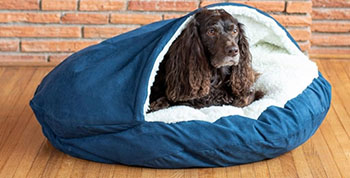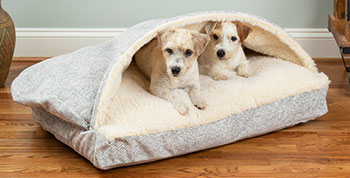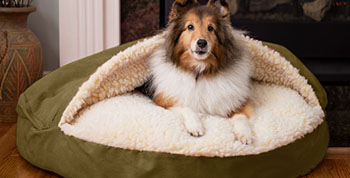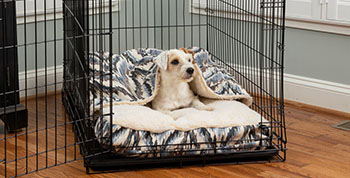Are Dogs Colorblind?
It’s a widely held belief that dogs are colorblind and don’t see many colors, but is that true?
The answer isn’t a simple yes or no. To fully answer the question, you have to understand how humans see color, how dogs see color, and how it’s different. You also have to know what “colorblind” means. Answering this question can do more than satisfy your curiosity; it can also help you understand how we dogs see the world.
So, are dogs colorblind? Let’s look into it.
How Do Humans See Color?
First, let’s see how vision works in humans. You probably learned about this in science class at some point, so here’s a quick refresher.
The human eye takes in light made up of photons of various wavelengths. Photoreceptor cells in the retina are responsible for processing the photons’ information and sending it onto the brain, where it’s interpreted in a way that leads to the experience of vision.
There are two types of photoreceptor cells, rods and cones. Cones, or cone cells, are responsible for the perception of color. (It’s easy to remember because “cones” and “color” both start with “C.”) Typically, there are three types of cones in the human eye. One type is sensitive to long wavelength light (reds), one to medium wavelength light (greens), and one to short wavelength light (blues). The way these cones respond to the wavelengths of the light coming into the eye determines how color is perceived. All three cone cell types must be present in order to have normal color vision.
Color blindness in humans occurs when someone is born with missing or mutated cones. For example, someone may be born missing the cones that are sensitive to medium wavelength light (greens) and will be red-green colorblind. Or they may be born with a mutated form of the cone that’s sensitive to short wavelength light (blues) and will be blue-yellow colorblind. Finally, some people are completely colorblind and see only in shades of black, white, and gray, but it’s exceedingly rare.
How Do Dog Eyes Work?
The eye of a dog is similar to the human eye in structure and function. Light enters the eye through the pupil, an opening that can be made larger to let more light in (in low-light conditions) or smaller to limit the amount of light coming in (when it’s bright out). The lens, located right behind the pupil, changes shape in order to focus the incoming light on the retina, which is located in the back of the eyeball.
The retina is where both types of photoreceptor cells – rods and cones – are. When light enters the eye, the rods and cones take this information, process it, and send it on through the optic nerve to the visual cortex at the back of the brain where the information is processed further.
So far, vision in dogs is the same as in humans. Where things differ is the numbers of the two types of photoreceptor cells.
Rods, or rod cells, are sensitive to lower levels of light and are necessary for peripheral vision. Rods help the eye see in the dark but are not sensitive to color, which is why you don’t distinguish colors well in low light. While humans have about 120 million rods, which is an impressive number, dogs have many more than that. We know that because we dogs are about much more sensitive to light than humans, and can see with light levels that are about a fifth as bright. They have many millions more rods than humans do.
Conversely, cones, which are responsible for color vision as discussed above, are found in greater numbers in humans than dogs. While the human eye has about 6-7 million cones, the dog eye has just a little over 1 million. This makes dogs less sensitive to color.
Are Dogs Actually Colorblind?
Remember that humans have trichromatic vision, thanks to three types of cones that detect different wavelengths of light – corresponding to blue, green, and red. In contrast, dogs have dichromatic vision – that is, they have only two types of cones. These two types are sensitive to blue light and yellow light. Lacking cones that are sensitive to red and green, we dogs don’t see colors the way you humans see them. But we do see colors.
So to answer the question, “are dogs actually colorblind?” – in a way yes, in a way no. It’s true that if a human saw the world the way a dog sees it, the human would be considered colorblind. That’s probably why some humans consider dogs to be colorblind. In that sense, yes.
But I believe the better answer is no, dogs are not colorblind. While we see the world in a way that’s very different from you humans, we do see color, in exactly the way we have evolved to see it.
What Colors Do Dogs See?
It’s impossible for science to know what the subjective experience of a dog is. That is, there’s no way to know how dogs experience color. But based on the cones and on research into the subject, it’s believed that dogs see the world in browns, yellows, grays, and blues.
Think of it like this: Humans see in a range of the colors of the rainbow – ROYGBIV – from red and orange to yellow and green to blue, indigo and violet. Dogs see in a range from browns and yellows on one end through grays and blues on the other. That’s what our “rainbow” looks like to us.
Since dogs don’t perceive reds, greens, and purples the way humans do, objects that are these colors will appear substantially different to dogs than humans. For instance, if you have a bunch of yellow tennis balls and one red tennis balls in a pile, to your dog the red tennis ball may appear yellow like all the others, since they don’t perceive red like humans do. The red tennis ball may still appear different, however, due to brightness or some other quality.
Picking the Right Colors for Your Dog and for You
Humans are likely to pick out toys, clothes, bedding, and more for their dogs based on their own preferences, without thinking of how their dog will perceive the same items.
But next time you buy your dog a toy, think about how they will see it. Those red and orange squeaky toys look fun to you, but to your dog they likely appear as greeny-brown. If you play outside a lot, toys of this color can easily blend in with the grass, which also appears a little more brown than green to dogs. A bright blue toy is probably better, as dogs see blues very well and the color contrasts with the grass, or else bright yellow, which dogs also see well.
When it comes to choosing a dog bed, it’s not as important to pick something easily distinguishable. Instead, you can pick something that fits in well with your décor. Snoozer has a wide range of dog beds depending on your dog’s needs and they all come in a variety of colors and patterns. The Pool & Patio Round Dog Bed comes in 10 fun patterns while the Luxury Dog Sofa comes in 19 colors and patterns, for instance. Browse the whole collection to see more.
– Maple


















